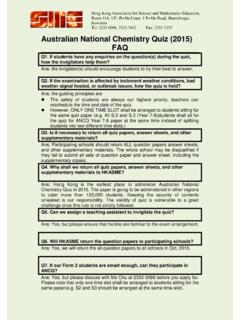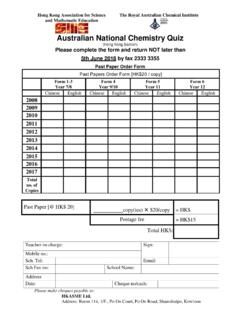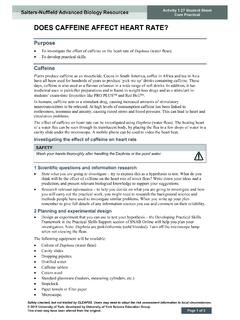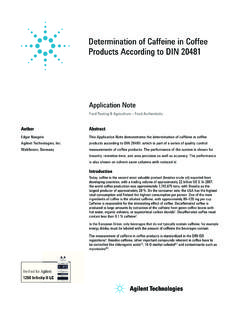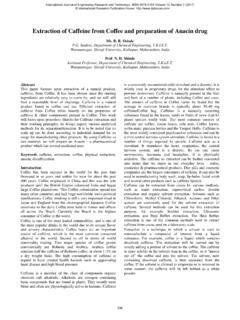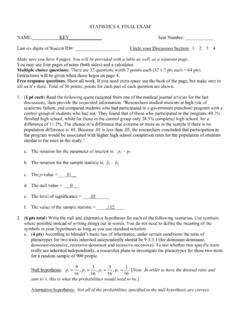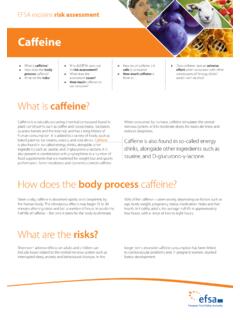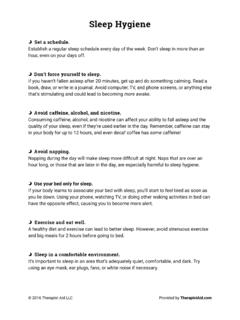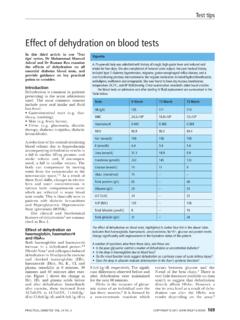Transcription of Chemical Test for Caffeine
1 1 Christian Alliance S C Chan Memorial College/2013-14 Chemistry Olympiad/ Caffeine Hong Kong Chemistry Olympiad for Secondary Schools (2013-14) Chemical Test for Caffeine Christian Alliance S C Chan Memorial College Ho Chun Lok ( ) Kwok Man Kit ( ) Chan Kam Tung ( ) Tse Sze Ho ( ) 2 Christian Alliance S C Chan Memorial College/2013-14 Chemistry Olympiad/ Caffeine Contents Abstract .. 3 Objective .. 4 Principle .. 5-7 Solvent Extraction .. 5 Thin Layer Chromatography .. 5 Iodometric Back Titration .. 6 Spike Apparatus and Chemicals .. 8 Experimental Methods and Procedure .. 9-13 Solvent Extraction .. 9 Thin Layer Chromatography.
2 11 Iodometric Back Titration .. 12 Spike test ..13 Result .. 14-18 Solvent Extraction .. 14 Thin Layer Chromatography .. 16 Iodometric Back Titration .. 18 Spike test ..17 Discussion .. 21 Conclusion .. 22 Further Work .. 23 Reference .. 24 3 Christian Alliance S C Chan Memorial College/2013-14 Chemistry Olympiad/ Caffeine Abstract We are interested in the alkaloid --- Caffeine (C8H10N4O2) which is very common substance in many drinks, such as coffee, tea, Coca-Cola etc. Adults or even students will drink a cup of coffee to temporarily restoring alertness and warding off drowsiness. However, how much Caffeine in our coffee? How can we determine the amount of Caffeine in coffee?
3 The following project will investigate the Chemical test for Caffeine . At first, we extract Caffeine from coffee. Then we need to prove that the extraction contain Caffeine . Finally we try to find out the amount of Caffeine in coffee. We ll first follow the common procedure, which is the solvent extraction and the thin layer chromatography. We also do some research on other Chemical test for Caffeine . We come up with the test of iodometric back titration. All the tests we investigate can be done in school laboratory, and pure Caffeine is bought for verifying and investigating these Chemical tests. We hope that these tests can be further developed in order to become more popular, more efficient, lower the cost and less pollute to environment.
4 Structure of Caffeine [1] 4 Christian Alliance S C Chan Memorial College/2013-14 Chemistry Olympiad/ Caffeine Objective First, we try to extract Caffeine from coffee by a suitable method. Then, by using Chemical tests to analysis the amount of Caffeine in coffee and extract. Last, we want to validate the efficiency of the extraction method. 5 Christian Alliance S C Chan Memorial College/2013-14 Chemistry Olympiad/ Caffeine Principles Solvent extraction [2] It mainly based on the difference of solubility of Caffeine in different solvent. Caffeine is sparingly soluble in water at room temperature but highly soluble in boiling water (100 C).
5 Thus we can extract most of Caffeine in raw coffee powder to a coffee solution. Then, in order to extract crude Caffeine from coffee solution, we can base on the property that Caffeine is more soluble in organic solvent (here we use chloroform (CHCl3)) than that in water at room temperature. Also chloroform is much denser than water and insoluble in water, the Caffeine in coffee solution are transferred to the chloroform and separated out. Water (25 C ) Chloroform (25 C) Water (100 C ) Caffeine solubility g/100 cm3 g/100 cm3 g/100 cm3 [3] Then to prove that the extraction is mainly Caffeine , we can carry out two tests, which are Thin Layer Chromatography (TLC) and iodometric back titration.
6 Thin Layer Chromatography (TLC) There are different types of chromatographic methods such as paper chromatography, thin-layer chromatography, column chromatography, gas chromatography, etc. They have the same principle : (1) Different solutes have different solubility in a solvent /different solutes have different degrees of tendency to be dissolved in the same solvent. (2) As the solution ( contains the solvent with the dissolved solutes ) moves along a stationary solid surface ( a solid surface ) , different solutes adsorbed onto the solid surface in different extent as they have different degree of adsorption characteristics ( due to the different degrees of dissolve tendency).
7 6 Christian Alliance S C Chan Memorial College/2013-14 Chemistry Olympiad/ Caffeine (3) The less soluble solute will be retained first, and the more soluble solutes will be retained afterwards. ( Note : No two substances have the same solubility and adsorption characteristics. ) (4) Different solutes will then be separated on the different positions of the solid surface. (5) Retention Factor (Rf) of each components is calculated as follow Rf = distance traveled by the component substance form the baseline distance traveled by the solvent from the baseline Pure Caffeine and the extract are analyzed in the same TLC plate and compare any differences of their Rf.
8 7 Christian Alliance S C Chan Memorial College/2013-14 Chemistry Olympiad/ Caffeine Iodometric Back Titration Caffeine reacts with excess accurately known amount of iodine in acidic environment, forming insoluble precipitate. Then the insoluble precipitate is removed by filtration. Using titration by a standard sodium thiosulphate solution with starch solution as indicator, we can determine the amount of remaining iodine, and thus the amount of Caffeine can be found. Here are the Chemical equations [4]: C8H10N4O2 + 2 I2 + KI + H2SO4 C8H10N4O2 .HI .I4 + KHSO4 I2 + 2 Na2S2O3 2 NaI + Na2S4O6 Note : Where the second equation is to determine the remaining iodine (I2 is the remaining Iodine) 8 Christian Alliance S C Chan Memorial College/2013-14 Chemistry Olympiad/ Caffeine Spike Test By adding known amount of standard Caffeine in distilled water and raw coffee solution , then carry out solvent extraction.
9 By comparing the extraction results, we can analyze the recovery percentage of the spiked Caffeine and efficiency of solvent extraction. Chemicals Caffeine (C8H10N4O2 , Chemical pure grade, min ) Solvent Extraction : Chloroform (CHCl3) TLC Ethyl Acetate (C4H8O2) Ethanoic acid Iodometric back titration Standard Caffeine solution Standard Na2S2O3 solution Standardized iodine solution Starch solution Apparatus Separating funnel TLC plate ( silica gel ) Burette Pipette Volumetric flask Analytical balance 9 Christian Alliance S C Chan Memorial College/2013-14 Chemistry Olympiad/ Caffeine Experimental Methods and Procedures (A) Extraction of Caffeine from raw coffee power Preparation of raw coffee solution 1.
10 Of fine grinded raw coffee powder is weighted, add 100 cm3 of distilled water and of sodium carbonate to increase solubility of Caffeine (alkaloid) and boil it and brew it by following the instruction on the Coffee package (one tablespoon of coffee powder in 100 cm3 of hot water, about /100 cm3). 2. Cool down the raw coffee solution to room temperature Solvent Extraction 1. Rinse all apparatus with chloroform. 2. Transfer the raw coffee solution to separating funnel (Figure a). 3. Add 10 cm3 of chloroform and swirl vigorously, (*Don t shake the mixture because an emulsion will form*)(Figure b). Allow the mixture to stand and separate out the bottom chloroform layer to a beaker.
